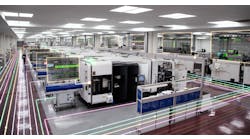Manufacturers involved with make-to-order business models or capital equipment are project-oriented – whether engaged in engineer-to-order construction, new product introduction or refits, lifecycle extensions on their own assets or customer assets. They need Enterprise Resource Planning (ERP) systems that connect the shop floor and work order schedules directly into a project.
When planning and executing manufacturing projects, difficulties may arise when project managers try to track two important metrics: estimate to complete by hours—the forecasted number of hours and dollars to complete the project, and estimate at completion by hours— the forecasted cost of the project at completion.
Here are three situations where project cost allocation is critical:
• When profitability, capacity, and customer service are linked – This is most common when both profitability and firm commitments to the customer (or customer experience) are important. If you spend more than anticipated on labor or materials in certain phases of the project and do not realize it until much later, you could find you have run out of budget or internal capacity — including manhours and equipment — to complete the work.
• Where manufacturers are involved in government supply chains – Defense manufacturers dealing with government entities require Cost Reimbursement and Cost-Plus contracts, which demand rigorous tracking of project or system cost, so a standard markup can be applied, up to a pre-set limit. Other contract forms include earned-value management, time and materials, and even performance-based logistics, where the entire product lifecycle must be managed profitably as a project.
• In program-based manufacturing agreements – Manufacturers in the automotive industry or commercial aviation space may find themselves involved in program-based manufacturing, which requires them to dovetail their engineer-to-order and manufacturing activities with their customer’s new product development cycle.
Current tools missing the mark — Traditional ERP software and its predecessor, materials requirements planning (MRP), were designed originally to match resources and demand in a repetitive manufacturing environment. However, the disciplines required for project-driven manufacturing, program-centric manufacturing, and engineer-to-order involve dealing with many unknown variables.
Software used in these settings must be designed specifically to manage project risk and to allocate resources and cost across multiple projects all competing for the same productive capacity. Too often, manufacturers will rely on project management or project portfolio management software. While tools like Microsoft Project or Primavera are very capable standalone project-management tools, the problem is exactly that – they stand alone.
By tracking load against resources outside of ERP, manufacturers are not truly managing the project from a financial and costing standpoint. They are merely using what is essentially an operations or scheduling tool which, at most, encompasses manufacturing time and attendance or work centers for engineers.
Some manufacturers, as they attack the problem of cost allocation in complex project environments, will talk about tracking their resources in terms of how many hours or people they have and begin to allocate them appropriately. This may be done on a project-by-project basis. But in order to optimize this, planners should know what jobs they have not only today but into next year. Then, they can start with an understanding of what resources are allocated to existing work during specific periods of time and which are not.
Pressure from OEMs growing — At IFS we have seen the need to manage project resources to meet the needs of OEMs has become more common in ERP software RFIs from manufacturers. It was not as prevalent before, which suggests that OEMs are pushing down more of the project-accounting requirements to their vendors, where much of the value is delivered anyway.
Planners need to know not only what other jobs they have now but also ones they will have in the future. Then, they can start with an understanding of what resources are allocated to existing work. This means if they take on a new job, they can allocate resources not only in light of a specific project requirement, but with an understanding of their existing or even anticipated resource load. This more powerful functionality helps planners to answer not only project-oriented but enterprise-level questions, and allow them to accurately quote lead times and cost. They can do this as they will know even before the project starts where and when they may need more employees, or even contractors to take on some of the work.
ERP solutions also should be designed for the modern project environment and able to forecast throughout the life of a project. During that project lifecycle, things change. You may have anticipated needing 10 people for 10 weeks, but maybe the customer has changed the scope. If fewer people are required, can you reallocate them to other projects?
If more resources are required, do you have existing people who can be placed onto the project or do you need to hire, outsource, approve overtime or take other measures? Perhaps a long lead time item is delayed due to a commodity shortage or vendor bottleneck. That impacts the rest of the schedule. ERP designed for the project manufacturer must enable the reallocation of hours and costs.
Supporting software on detail — The optimal software tool for this task will dig deeper to several more layers of granularity: Which manufacturing disciplines and capacities can I commit to the project, which engineers with which skill sets, how many project managers and how much inventory is available?
The software should overlay this more granular view of capacity in the quoting process to estimate the number of hours and compare it to current capacity usage. This lets you move from quoted plans into actual plans for resources once you win the work. Manufacturers are then able to take the forecast and turn it into an actual resource plan that has accurate productive capacity behind it. The plan becomes not just hours and graphics on a Gantt chart, but dollars. Your software tool must deal with hours and dollars in concert. In a fully integrated project ERP, you can generate more tasks and activities linked to work orders or shop orders to generate a flexible, fine-grained schedule and cost story.
Preparing for new-age manufacturing — Manufacturing is not standing still. Processes have changed. At any given time, planners will need to look at an individual project or a changing portfolio of projects and identify what each have cost to date, and what they will cost on completion. This must happen in the context of data from throughout the enterprise, including information on total resource loading across all projects.
In order to nail down reliable ETC and EAC figures, it is essential that project functionality is part and parcel of the ERP system, rather than two separate applications that are united in a point-to-point integration. Any demand put into a project that requires you to generate a shop order or a work order, or put a resource in the field must accrue against resources available at that time and affect the total cost of the project. And that means that project functionality must be embedded in the system of record, the ERP system.
No separate project management tool is going to automatically create those transactions in your ERP system of record. One integrated solution manages not just resources but demands, all managed to the project schedule.
Carrie Ghai is a senior business solutions consultant, North America, with IFS. Contact her via LinkedIn.








